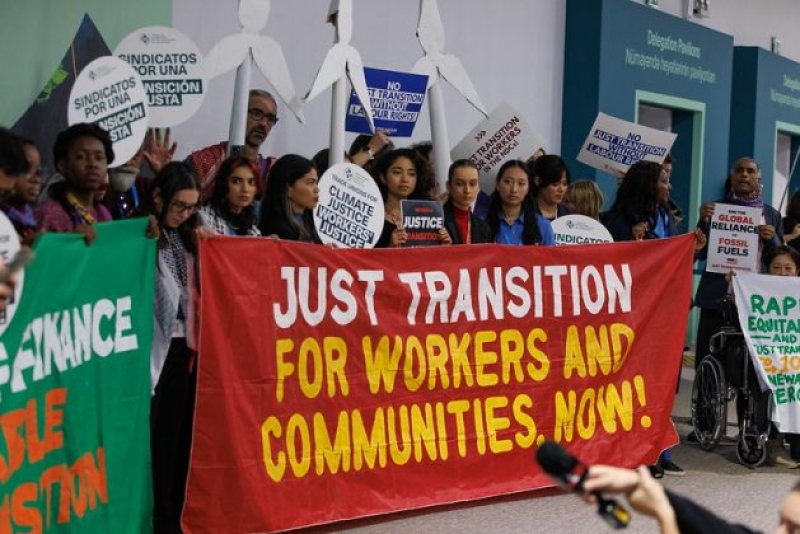- UNGA urges renewed int’l efforts for a resolution of Rohingya crisis |
- First National AI Readiness Assessment Report Published |
- China calls for implementation roadmap for new finance goal |
- New gas reserve found in old well at Sylhet Kailashtila field |
- Revenue earnings shortfall widens in October |
Why COP29 New Collective Quantified Goal on Climate Finance Matters

Action- Just Transition Credit- UN Climate Change-Kamran Guliye
By Joyce Chimbi
BAKU, Nov 19 2024 (IPS) - The industrial revolution set the ball rolling towards global warming. Today, developing nations are on the frontlines of a climatic carnage and its snowballing effects. Developed nations bear a financial responsibility to provide climate finance to developing nations, as financing the transition to a low-carbon economy is an urgent, critical matter.
This year, 2024, is already on track to become the hottest in recorded human history. Decarbonization will help meet the Paris Agreement goals, avoid climate catastrophe and safeguard the planet for generations. It is for this reason that COP29 prioritised negotiations towards a New Collective Quantified Goal (NCQG) on climate finance.
NCGQ is a key element of the 2015 Paris Agreement. It seeks to set a new financial target to support climate action in developing nations post-2025. In 2009, during the Copenhagen Climate Change Conference, a climate finance goal was set at USD 100 billion per year. For many years, the goal remained elusive and was only fully achieved in 2022.
The current goal to finance climate action in developing countries for the period 2020-2025 is USD 100 billion. In the post-2025 period, a new global goal to finance climate action is needed. This is the genesis and basis for COP29 Baku NCQG on climate finance.
Research shows that the “concentration of carbon dioxide in the atmosphere has increased from approximately 278 parts per million in 1750, the beginning of the industrial era, to 420 parts per million in 2023. The rise in heat-trapping carbon dioxide—and other greenhouse gases—is the primary reason for the planet’s soaring temperatures.”
With soaring temperatures, climate-driven disasters and the infinite cost of climate change are edging closer to reaching irreversible highs. For this reason, climate finance needed to reverse and halt the pace of climate change is no longer in the billions but trillions. Meanwhile, the signatories of the Paris Agreement are currently working on the third generation of nationally determined contributions (NDCs).
New NDCs will be submitted by February 10, 2025 and will incorporate the Global Stocktake agreed at COP28. The Global Stocktake evaluated progress on climate action at the global level against the goals of the Paris Agreement. NDCs are efforts each country commits to take to reduce emissions and adapt to climate change.
Within this context, the new collective quantified goal on climate finance is critical, as amounts of funds set aside for the NCQG will determine whether developing countries can, and to what extent finance their respective climate action in line with their national commitments or the NDCs.
UNFCCC’s Standing Committee on Finance estimates that the cost of implementing the third-generation NDCs will be USD 5.8-USD 5.9 trillion cumulatively by 2030. Developing countries are asking for at least USD 1 trillion in annual public support for the world’s most vulnerable nations to finance climate action once the current financial commitment of USD 100 billion lapses in 2025.
Delegates from developing nations say the current financing landscape is untenable as nearly 69 percent of all climate finance is provided in loans, entrenching and deepening existing inequalities and exacerbating debt crises in climate-vulnerable poor countries.
The global South is overwhelmingly asking for not less than USD 1 trillion per year in public granting support to replace the current USD 100 billion and they say that this is a drop in the ocean against the global GDP. The world generates nearly USD 100 trillion in GDP every year.
A fraction of that—just USD 1 trillion invested into climate action in developing nations—could drive a much-needed energy transition. A green revolution would decarbonise the economy and environment and rescue the world’s vulnerable, poor and underdeveloped nations from the jaws of a climate catastrophe before it is too late.
Back in 2009, acknowledging and taking responsibility for their substantial contribution to the climate crisis, developed countries agreed to mobilise USD 100 billion of climate finance a year by 2020 to run through 2025. Today, in Baku, developed countries are being asked to lift the billions into the trillion bracket. With only days to go until the end of the COP29 summit, it remains to be seen whether, at last, rich countries will agree to replace billions with trillions.
IPS UN Bureau Report

